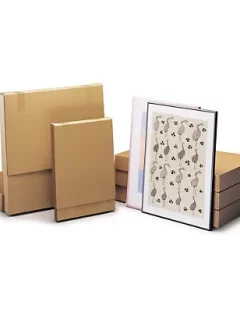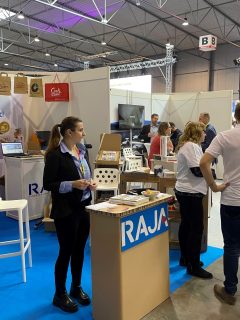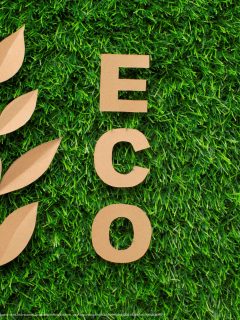Today, paper packaging is a symbol of sustainability – and plastic is often seen as the enemy of the planet. But is it really that simple? Packaging ecology is not black and white. For a company to make a truly responsible choice, it needs to look deeper: at the carbon footprint, the recycling options, but also the purpose of use. At RAJA, we know packaging materials in depth – we bring you a comparison of the two options without prejudice.
♻️ Paper: natural, recyclable, but…
Advantages:
- The paper comes from renewable sources (e.g. FSC®, PEFC™ certification).
- It is well recyclable, even several times in a row.
- In customer perception, paper is synonymous with the “eco approach”.
Disadvantages:
- Paper production is water and energy intensive.
- Paper packaging is not always durable enough – it loses strength when wet.
- When packaging fragile goods, it may be necessary to use multiple layers – increasing material consumption.
📌 For lightweight products or textiles, paper packaging is a great option. But if you’re wrapping heavy items or sending goods to a humid environment, it can be a limitation.
🧴 Plastic: efficient, lightweight, but perceived negatively
Pros:
- Lightweight – lower transport carbon footprint.
- It is waterproof, strong and often protects goods better (e.g. bubble wrap, stretch).
- Can be recycled several times if the system is right.
Disadvantages:
- It has a “bad name” in the eyes of the public.
- If not sorted properly, it often ends up in landfills or in the environment.
- Some types of plastic are only recyclable to a limited extent (e.g. mixed films or multi-layer films).
📌 When shipping electronics or heavy machinery parts, plastic is often the safest option – it prevents damage even in extreme conditions.
🌍 What does ecology and carbon footprint say?
- The life cycle of packaging is key. Plastic can have a lower impact on the climate than paper if it is recycled and used more than once.
- The volume and weight of the packaging is also important. Plastic filling can be smaller in volume and weight → lower transport costs = lower CO₂ emissions.
- It is best to choose the material according to the purpose. There is no universally “greenest” packaging. It is wise to seek a balance between functionality, material and recyclability.
✅ How to choose sustainably?
Choosing the right packaging is always a compromise between product protection, environmental impact and cost-effectiveness. At RAJA, we help our customers find the best balance with regard to the type of goods, the mode of transport and their specific needs.
- Prefer recycled and recyclable materials when the nature of the goods and logistics allow it. However, functionality and safety of packaging should always be taken into account.
- Choose packaging from responsible sources (e.g. FSC® certification, use of recyclates), but always taking into account the overall environmental impact and the availability of recycling infrastructure in your location.
- Try to minimize unnecessary packaging and filling materials, but never at the expense of product protection that could lead to increased waste from claims or damaged shipments.
- Consider combinations of materials to ensure optimum protection as well as easy recyclability – for example, a cardboard exterior with a plastic filler that is both highly protective and recyclable.
When it comes to being green, it’s not enough to just ‘do what looks green’ – it’s important to think in context. At RAJA, we help companies choose packaging that makes sense environmentally and economically. Whether you reach for paper or plastic, the key is to make a conscious decision and manage your waste correctly.














